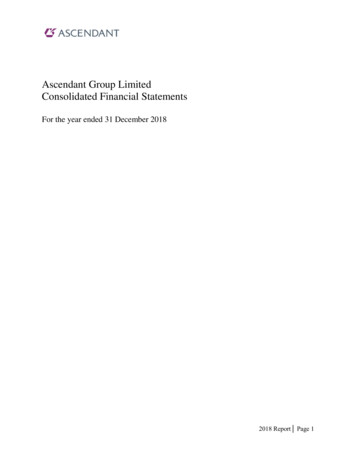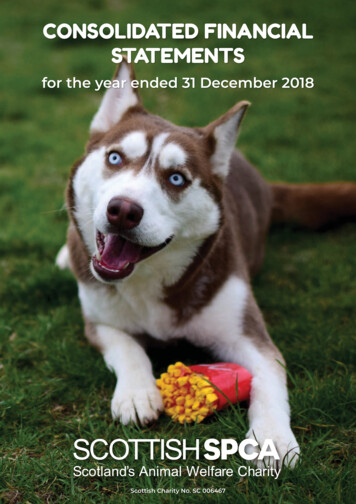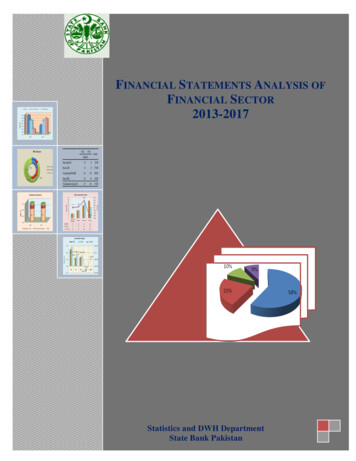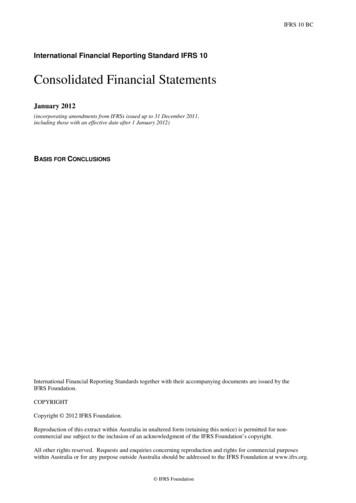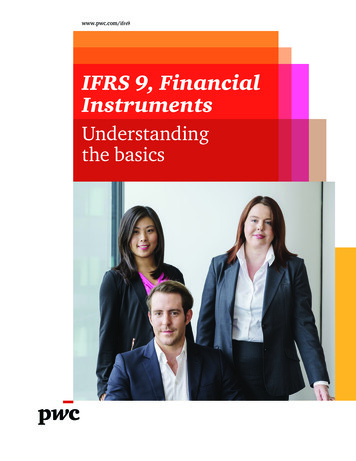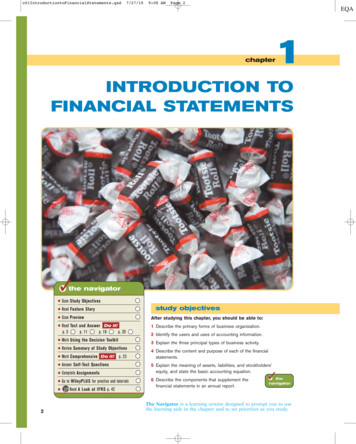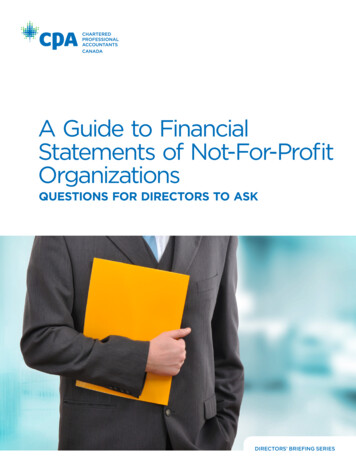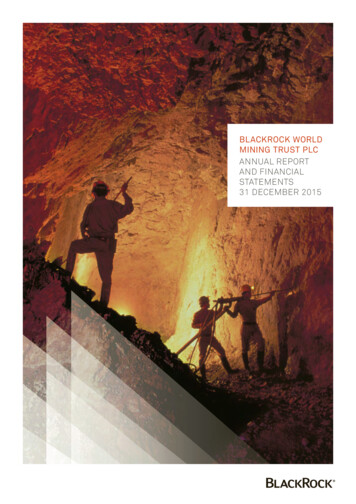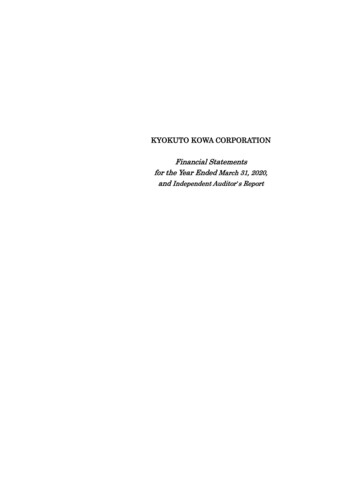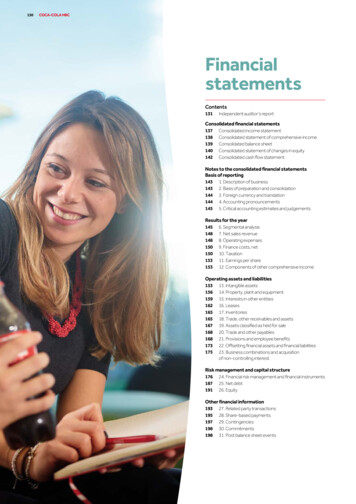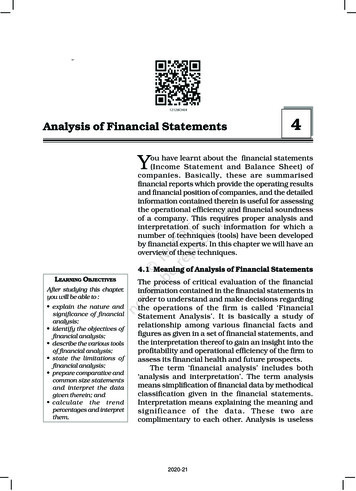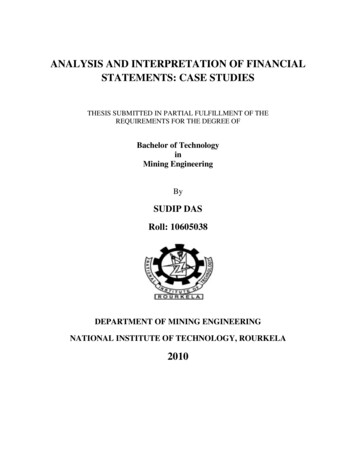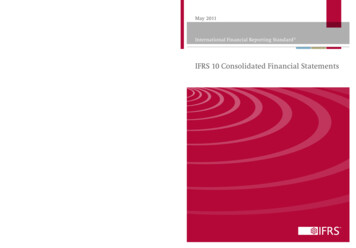
Transcription
May 2011International Financial Reporting Standard IFRS 10 Consolidated Financial StatementsStandard ISBN 978-1-907877-15-5International Accounting Standards Board (IASB)The IASB is the independent standard-setting body of the IFRS Foundation30 Cannon Street London EC4M 6XH United KingdomTelephone: 44 (0)20 7246 6410 Fax: 44 (0)20 7246 6411Email: info@ifrs.org Web: www.ifrs.orgPublications DepartmentTelephone: 44 (0)20 7332 2730 Fax: 44 (0)20 7332 2749Email: publications@ifrs.org100%50%Cover printed on 100 per cent recycled paperText printed on 50 per cent recycled paper
International FinancialReporting Standard 10Consolidated Financial Statements
IFRS 10 Consolidated Financial Statements is issued by the International AccountingStandards Board (IASB), 30 Cannon Street, London EC4M 6XH, United Kingdom.Tel: 44 (0)20 7246 6410Fax: 44 (0)20 7246 6411Email: iasb@ifrs.orgWeb: www.ifrs.orgThe IASB, the IFRS Foundation, the authors and the publishers do not acceptresponsibility for loss caused to any person who acts or refrains from acting inreliance on the material in this publication, whether such loss is caused bynegligence or otherwise.Copyright 2011 IFRS Foundation IFRS 10 and its accompanying documents are published in two parts.ISBN for this part: 978-1-907877-12-4ISBN for complete publication (two parts): 978-1-907877-11-7International Financial Reporting Standards (including International AccountingStandards and SIC and IFRIC Interpretations), Exposure Drafts, and other IASBpublications are copyright of the IFRS Foundation. The approved text ofInternational Financial Reporting Standards and other IASB publications is thatpublished by the IASB in the English language. Copies may be obtained from theIFRS Foundation. Please address publications and copyright matters to:IFRS Foundation Publications Department,1st Floor, 30 Cannon Street, London EC4M 6XH, United Kingdom.Tel: 44 (0)20 7332 2730 Fax: 44 (0)20 7332 2749Email: publications@ifrs.org Web: www.ifrs.orgAll rights reserved. No part of this publication may be translated, reprinted orreproduced or utilised in any form either in whole or in part or by any electronic,mechanical or other means, now known or hereafter invented, includingphotocopying and recording, or in any information storage and retrieval system,without prior permission in writing from the IFRS Foundation.The IFRS Foundation logo/the IASB logo/‘Hexagon Device’, ‘IFRS Foundation’,‘eIFRS’, ‘IAS’, ‘IASB’, ‘IASC Foundation’, ‘IASCF’, ‘IFRS for SMEs’, ‘IASs’, ‘IFRIC’,‘IFRS’, ‘IFRSs’, ‘International Accounting Standards’, ‘International FinancialReporting Standards’ and ‘SIC’ are Trade Marks of the IFRS Foundation.
IFRS 10 CONSOLIDATED FINANCIAL INTERNATIONAL FINANCIAL REPORTING STANDARD 10CONSOLIDATED FINANCIAL STATEMENTSOBJECTIVE1–3Meeting the ns15–16Link between power and returns17–18ACCOUNTING REQUIREMENTS19–26Non-controlling interests22–24Loss of control25–26APPENDICESA Defined termsB Application guidanceB1–B99Assessing controlB2–B85Purpose and design of an investeePowerExposure, or rights, to variable returns from an investeeLink between power and returnsRelationship with other partiesControl of specified assetsContinuous 85B76–B79B80–B85Accounting requirementsB86–B99Consolidation proceduresUniform accounting policiesMeasurementPotential voting rightsReporting dateNon-controlling interestsLoss of 99C Effective date and transitionD Amendments to other IFRSs3 IFRS Foundation
INTERNATIONAL FINANCIAL REPORTING STANDARD MAY 2011APPROVAL BY THE BOARD OF IFRS 10 ISSUED IN MAY 2011BASIS FOR CONCLUSIONS (see separate booklet)APPENDIXAmendments to the Basis for Conclusions on other IFRSsAMENDMENTS TO THE GUIDANCE ON OTHER IFRSs IFRS Foundation4
IFRS 10 CONSOLIDATED FINANCIAL STATEMENTSInternational Financial Reporting Standard 10 Consolidated Financial Statements(IFRS 10) is set out in paragraphs 1–26 and Appendices A–D. All the paragraphshave equal authority. Paragraphs in bold type state the main principles. Termsdefined in Appendix A are in italics the first time they appear in the Standard.Definitions of other terms are given in the Glossary for International FinancialReporting Standards. IFRS 10 should be read in the context of its objective andthe Basis for Conclusions, the Preface to International Financial Reporting Standardsand the Conceptual Framework for Financial Reporting. IAS 8 Accounting Policies,Changes in Accounting Estimates and Errors provides a basis for selecting andapplying accounting policies in the absence of explicit guidance.5 IFRS Foundation
INTERNATIONAL FINANCIAL REPORTING STANDARD MAY 2011IntroductionIN1IFRS 10 Consolidated Financial Statements establishes principles for thepresentation and preparation of consolidated financial statements whenan entity controls one or more other entities.IN2The IFRS supersedes IAS 27 Consolidated and Separate Financial Statements andSIC-12 Consolidation—Special Purpose Entities and is effective for annual periodsbeginning on or after 1 January 2013. Earlier application is permitted.Reasons for issuing the IFRSIN3The Board added a project on consolidation to its agenda to deal withdivergence in practice in applying IAS 27 and SIC-12. For example,entities varied in their application of the control concept incircumstances in which a reporting entity controls another entity butholds less than a majority of the voting rights of the entity, and incircumstances involving agency relationships.IN4In addition, a perceived conflict of emphasis between IAS 27 and SIC-12had led to inconsistent application of the concept of control. IAS 27required the consolidation of entities that are controlled by a reportingentity, and it defined control as the power to govern the financial andoperating policies of an entity so as to obtain benefits from its activities.SIC-12, which interpreted the requirements of IAS 27 in the context ofspecial purpose entities, placed greater emphasis on risks and rewards.IN5The global financial crisis that started in 2007 highlighted the lack oftransparency about the risks to which investors were exposed from theirinvolvement with ‘off balance sheet vehicles’ (such as securitisationvehicles), including those that they had set up or sponsored. As a result,the G20 leaders, the Financial Stability Board and others asked the Boardto review the accounting and disclosure requirements for such ‘offbalance sheet vehicles’.Main features of the IFRSIN6The IFRS requires an entity that is a parent to present consolidatedfinancial statements. A limited exemption is available to some entities.General requirementsIN7The IFRS defines the principle of control and establishes control as thebasis for determining which entities are consolidated in the consolidated IFRS Foundation6
IFRS 10 CONSOLIDATED FINANCIAL STATEMENTSfinancial statements. The IFRS also sets out the accounting requirementsfor the preparation of consolidated financial statements.IN8IN9An investor controls an investee when it is exposed, or has rights, tovariable returns from its involvement with the investee and has theability to affect those returns through its power over the investee. Thus,the principle of control sets out the following three elements of control:(a)power over the investee;(b)exposure, or rights, to variable returns from involvement with theinvestee; and(c)the ability to use power over the investee to affect the amount ofthe investor’s returns.The IFRS sets out requirements on how to apply the control principle:(a)in circumstances when voting rights or similar rights give aninvestor power, including situations where the investor holds lessthan a majority of voting rights and in circumstances involvingpotential voting rights.(b)in circumstances when an investee is designed so that voting rightsare not the dominant factor in deciding who controls the investee,such as when any voting rights relate to administrative tasks onlyand the relevant activities are directed by means of contractualarrangements.(c)in circumstances involving agency relationships.(d)in circumstances when the investor has control over specifiedassets of an investee.IN10The IFRS requires an investor to reassess whether it controls an investeeif facts and circumstances indicate that there are changes to one or moreof the three elements of control.IN11When preparing consolidated financial statements, an entity must useuniform accounting policies for reporting like transactions and otherevents in similar circumstances. Intragroup balances and transactionsmust be eliminated. Non-controlling interests in subsidiaries must bepresented in the consolidated statement of financial position withinequity, separately from the equity of the owners of the parent.IN12The disclosure requirements for interests in subsidiaries are specified inIFRS 12 Disclosure of Interests in Other Entities.7 IFRS Foundation
INTERNATIONAL FINANCIAL REPORTING STANDARD MAY 2011International Financial Reporting Standard 10Consolidated Financial StatementsObjective1The objective of this IFRS is to establish principles for the presentationand preparation of consolidated financial statements when an entitycontrols one or more other entities.Meeting the objective23To meet the objective in paragraph 1, this IFRS:(a)requires an entity (the parent) that controls one or more otherentities (subsidiaries) to present consolidated financial statements;(b)defines the principle of control, and establishes control as the basisfor consolidation;(c)sets out how to apply the principle of control to identify whetheran investor controls an investee and therefore must consolidate theinvestee; and(d)sets out the accounting requirements for the preparation ofconsolidated financial statements.This IFRS does not deal with the accounting requirements for businesscombinations and their effect on consolidation, including goodwillarising on a business combination (see IFRS 3 Business Combinations).Scope4An entity that is a parent shall present consolidated financial statements.This IFRS applies to all entities, except as follows:(a)a parent need not present consolidated financial statements if itmeets all the following conditions:(i) IFRS Foundationit is a wholly-owned subsidiary or is a partially-ownedsubsidiary of another entity and all its other owners,including those not otherwise entitled to vote, have beeninformed about, and do not object to, the parent notpresenting consolidated financial statements;8
IFRS 10 CONSOLIDATED FINANCIAL STATEMENTS(b)(ii)its debt or equity instruments are not traded in a publicmarket (a domestic or foreign stock exchange or anover-the-counter market, including local and regionalmarkets);(iii)it did not file, nor is it in the process of filing, its financialstatements with a securities commission or other regulatoryorganisation for the purpose of issuing any class ofinstruments in a public market; and(iv)its ultimate or any intermediate parent producesconsolidated financial statements that are available forpublic use and comply with IFRSs.post-employment benefit plans or other long-term employeebenefit plans to which IAS 19 Employee Benefits applies.Control5An investor, regardless of the nature of its involvement with an entity(the investee), shall determine whether it is a parent by assessing whetherit controls the investee.6An investor controls an investee when it is exposed, or has rights, tovariable returns from its involvement with the investee and has theability to affect those returns through its power over the investee.7Thus, an investor controls an investee if and only if the investor has all thefollowing:8(a)power over the investee (see paragraphs 10–14);(b)exposure, or rights, to variable returns from its involvement withthe investee (see paragraphs 15 and 16); and(c)the ability to use its power over the investee to affect the amount ofthe investor’s returns (see paragraphs 17 and 18).An investor shall consider all facts and circumstances when assessingwhether it controls an investee. The investor shall reassess whether itcontrols an investee if facts and circumstances indicate that there arechanges to one or more of the three elements of control listed inparagraph 7 (see paragraphs B80–B85).9 IFRS Foundation
INTERNATIONAL FINANCIAL REPORTING STANDARD MAY 20119Two or more investors collectively control an investee when they must acttogether to direct the relevant activities. In such cases, because noinvestor can direct the activities without the co-operation of the others,no investor individually controls the investee. Each investor wouldaccount for its interest in the investee in accordance with the relevantIFRSs, such as IFRS 11 Joint Arrangements, IAS 28 Investments in Associates andJoint Ventures or IFRS 9 Financial Instruments.Power10An investor has power over an investee when the investor has existingrights that give it the current ability to direct the relevant activities, ie theactivities that significantly affect the investee’s returns.11Power arises from rights. Sometimes assessing power is straightforward,such as when power over an investee is obtained directly and solely fromthe voting rights granted by equity instruments such as shares, and canbe assessed by considering the voting rights from those shareholdings.In other cases, the assessment will be more complex and require morethan one factor to be considered, for example when power results fromone or more contractual arrangements.12An investor with the current ability to direct the relevant activities haspower even if its rights to direct have yet to be exercised. Evidence thatthe investor has been directing relevant activities can help determinewhether the investor has power, but such evidence is not, in itself,conclusive in d
IFRS 10 Consolidated Financial Statements May 2011 International Financial Reporting Standard International Accounting Standards Board (IASB) The IASB is the independent standard-setting body of the IFRS Foundation 30 Cannon Street London EC4M 6XH United Kingdom Telephone: 44 (0)20 7246 6410 Fax: 44 (0)20 7246 6411
